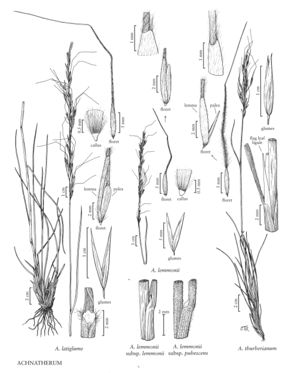Achnatherum thurberianum
Plants cespitose, not rhizomatous. Culms 30-75 cm tall, 0.5-1.7 mm thick, internodes pubescent or glabrous, pubescence more common on the lower internodes, particularly just below the nodes; nodes 2-3, lower nodes retrorsely pubescent, upper nodes glabrous or pubescent. Basal sheaths glabrous, usually smooth, brown or gray-brown; collars glabrous, without tufts of hair at the sides; basal ligules 1.5-6 mm, hyaline, rounded to acute, lacerate; upper ligules to 8 mm, hyaline, acute, glabrous; blades 0.5-2 mm wide, convolute, abaxial surfaces scabrous, adaxial surfaces scabrous or hairy, hairs about 0.3 mm. Panicles 7-15 cm long, 0.5-2.5 cm wide, often included in the upper leaf-sheaths at the start of anthesis; branches 1.5-6 cm, appressed to strongly ascending, with 1-6 spikelets. Glumes often purplish; lower glumes 10-15 mm long, 1.2-2 mm wide; upper glumes to 2 mm shorter; florets 6-9 mm long, 0.7-1.2 mm thick, fusiform, terete; calluses 0.9-1.5 mm, sharp; lemmas coriaceous, evenly pubescent or the back glabrate distally, hairs 0.5-0.8 mm, apices lobed on 1 margin, lobe about 0.1 mm long, thick, apical lemma hairs 0.5-0.8 mm; awns 32-56 mm, twice-geniculate, first 2 segments pilose, hairs 0.8-2 mm, terminal segment glabrous, often scabrous; paleas 4.6-6.1 mm, 3/4 - 9/10 as long as the lemmas, sparsely pubescent towards the base; anthers 2.5-3.5 mm, dehiscent, not penicillate. Caryopses 5-7 mm, fusiform. 2n =34.
Distribution
Wash., Utah, Calif., Colo., Oreg., Mont., Wyo., Idaho, Nev.
Discussion
Achnatherum thurberianum grows in canyons and foothills, primarily in sagebrush desert and juniper woodland associations, from Washington to southern Idaho and southwestern Montana and from California to Utah, at 900-3000 m. Its long ligules and pilose awns make it one of the easier North American species of Achnatherum to identify.
Selected References
None.
Lower Taxa
"decumbent" is not a number."thick" is not a number."prolonged" is not a number.
